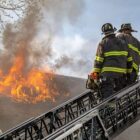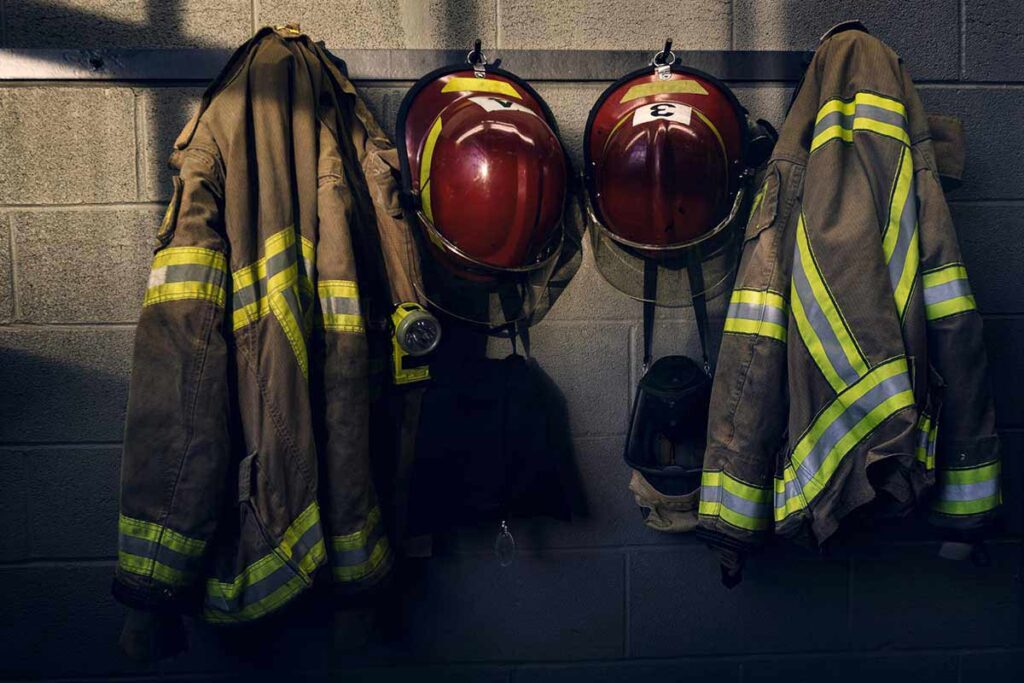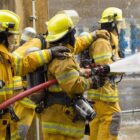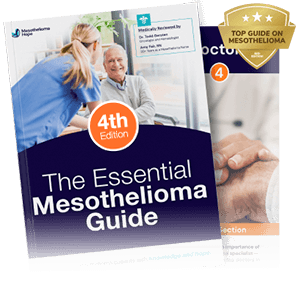Firefighters and Asbestos Exposure Risks
Firefighters protect the community by putting out dangerous blazes, but they can also be exposed unknowingly to toxic environmental hazards like asbestos.
Asbestos is a highly durable and fiber-like mineral that, when inhaled or ingested, can lead to mesothelioma and other deadly illnesses.
Firefighters should learn how to reduce the risks of asbestos exposure while they serve and what to do if they develop an asbestos-related disease.

How Firefighters Were Exposed to Asbestos
Asbestos was used for decades to make construction materials and protect workers from fires. When older buildings made with asbestos are damaged by fire, they can release large amounts of asbestos fibers and put firefighters at risk of exposure.
Construction Materials
From the 1930s to the 1980s, the construction industry used countless asbestos-containing products to build structures across the country.
Asbestos was used in:
- Adhesives and sealants
- Drywall board
- Electric wiring
- Exterior cement-board siding
- Fireproofing materials
- Floor and ceiling tiles
- Insulation (wall, ceiling, etc.)
- Masonry cement powder
- Paint
- Roofing shingles
- Sound deadening applications
When buildings with these products catch on fire, microscopic asbestos fibers can be released into the air. Once airborne, firefighters may inhale or swallow the fibers without notice and develop mesothelioma later in life.
Thousands of older structures built before the 1980s still contain asbestos construction products today.
Firefighters can also be exposed to asbestos in fire stations. For example, a 2019 lawsuit claimed that the city of San Diego relocated firefighters to buildings laced with asbestos and did not address the problem for decades.
Fire Cleanup Sites
Asbestos may continue to pose a threat even after a fire has been put out.
After a fire, asbestos can be found in:
- Air and smoke: Asbestos particles can be picked up by breezes or smoke and then inhaled by firefighters.
- Ash: Asbestos fibers may wind up in the smoldering ash or debris of a fire. Moving this ash can release microscopic fibers into the air.
- Damaged structures: After firefighters have put out a fire, any asbestos-based products in the buildings can be disturbed if precautions are not taken during the cleanup process.
Firefighter Asbestos Suits & Gear
Starting in the 1930s, firefighters wore protective clothing such as suits, gloves, boots, and helmets that contained asbestos.
Since asbestos is fireproof, it was thought to be perfect for this protective gear. Firefighters and their employers didn’t know asbestos was dangerous since manufacturers of asbestos-based products hid the health risks for decades.
Modern-day firefighting gear is not made with asbestos due to these dangers.

Fire Trucks
Between the 1930s and 1980s, asbestos was often used in fire trucks and other vehicles to reduce brake friction and prevent overheating.
Asbestos was used in fire engine:
- Brakes
- Clutches
- Gaskets
- Water hoses
These parts could wear down over time and release asbestos fibers into the air, putting firefighters and others nearby at risk of exposure.
Firefighters and Secondhand Asbestos Exposure
The risks of asbestos exposure don’t stop at the fire scene. Firefighters may transport microscopic fibers back to the fire station on their clothes, vehicles, and equipment, putting other firefighters at risk of secondhand exposure.
Family members can also suffer from secondhand exposure if a firefighter comes home without showering or properly cleaning their gear.
9/11 Firefighters and Asbestos Exposure
Firefighters and other first responders were put at a high risk of asbestos exposure on 9/11. The horrific attacks on the Twin Towers sent clouds of debris and toxic chemicals like asbestos into the air.
Adding to the problem was that not all first responders wore respirators, bravely putting the lives of the victims ahead of their own. Unfortunately, this also increased first responders’ risks of inhaling asbestos and other cancer-causing materials.
The Centers for Disease Control and Prevention (CDC) found that 52% of New York City firefighters did not wear a mask as the Twin Towers collapsed.
Firefighters who responded to 9/11 are still at risk today since asbestos-related diseases take 20-50 years to develop after exposure.
Asbestos-Related Diseases Among Firefighters
Mesothelioma
Firefighters may develop mesothelioma if asbestos fibers get lodged in the lining of the lungs, abdomen, or other organs. Once inside the body, asbestos fibers irritate healthy cells, potentially causing them to mutate and become cancerous.
A study by the National Institute for Occupational Safety and Health (NIOSH) found that firefighters are twice as likely to develop mesothelioma than the general population. The study specifically linked this higher rate of mesothelioma to asbestos exposure.
The International Association of Fire Fighters (IAFF) also found that firemen had a 100% higher chance of getting mesothelioma than non-firemen.
Other Cancers
Mesothelioma is not the only asbestos-caused cancer that affects firefighters. Asbestos fibers can cause cancer in other parts of the body as well.
Firefighters may also develop:
- Lung cancer
- Ovarian cancer
- Pancreatic cancer
- Stomach cancer
Non-Cancerous Asbestos Diseases
Asbestos exposure can also cause benign (non-cancerous) diseases, some of which can be painful or even deadly.
Non-cancerous asbestos diseases include:
- Asbestosis: This disease occurs when asbestos fibers get stuck in the lungs. The fibers severely scar the lungs and make breathing hard and painful.
- Pleural effusions: These are buildups of fluid in the lung lining. They may cause pain and discomfort, shortness of breath, and a persistent cough.
- Pleural plaques: Pleural plaques are chalky buildups of collagen in the lung linings. They are usually harmless, and most people have no symptoms. However, pleural plaques are sometimes a tell-tale sign of mesothelioma.
Other non-cancerous asbestos illnesses include atelectasis (collapsed lung) and chronic obstructive pulmonary disease (COPD).
Asbestos Safety Tips for Firefighters
Asbestos still presents a threat to firefighters today, but there are ways to reduce the risk of exposure and stay safe.
You can help lower your risk of asbestos exposure by:
- Wearing a self-contained breathing apparatus (SCBA) with a high-efficiency particulate air filter (HEPA) while extinguishing a fire
- Placing all asbestos-contaminated gear and equipment into bags after the fire has been extinguished
- Showering before returning home
- Ensuring that all asbestos-containing ash and debris have been properly disposed of

Mesothelioma and Firefighters: Next Steps
Firefighters today are required to wear PPE to keep them safe from asbestos and other toxic materials, but in the past, the dangers of asbestos exposure were not widely known.
Firefighters should monitor their health as they age, as mesothelioma and other asbestos-related diseases take decades to develop. Learn what steps at-risk firefighters can take below.
Watch for Mesothelioma Symptoms
The early signs of mesothelioma are usually mild, so they may be mistaken for symptoms of more common illnesses like the flu. However, mesothelioma symptoms only worsen over time unless treatment is sought.
Common symptoms of mesothelioma include:
- Chronic cough
- Difficulty breathing
- Fatigue
- Fluid buildup in chest or abdomen
- Rib, shoulder, or upper back pain
- Weight loss
Get a Diagnosis from a Mesothelioma Specialist
Those with possible mesothelioma symptoms should seek a diagnosis from a specialized doctor. Your primary care doctor may not know how to properly diagnose this cancer or even test for it in the first place since it is so rare.
Working with an experienced mesothelioma doctor can:
- Help to quickly rule out other diseases or cancers
- Reduce the risk of misdiagnosis
- Provide specific details about your mesothelioma type and stage
- Develop a personalized mesothelioma treatment plan for you
Mesothelioma doctors work with patients on a daily basis, so they are experts in diagnosing the cancer and can recommend the best treatment options depending on your diagnosis.
Seek Financial Compensation
Because manufacturers hid the risks of asbestos for decades, firefighters and others with mesothelioma may qualify for financial compensation.
Financial compensation can help cover:
- Medical expenses
- Travel costs
- Mortgages or rent
- Lost wages
- Any other expenses
There may be time limits to receive this money, so don’t delay. Get a free case review to see if you may qualify for mesothelioma compensation.



